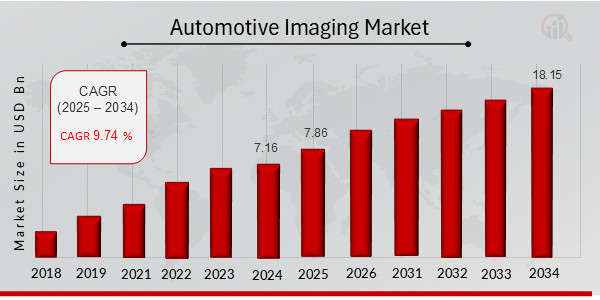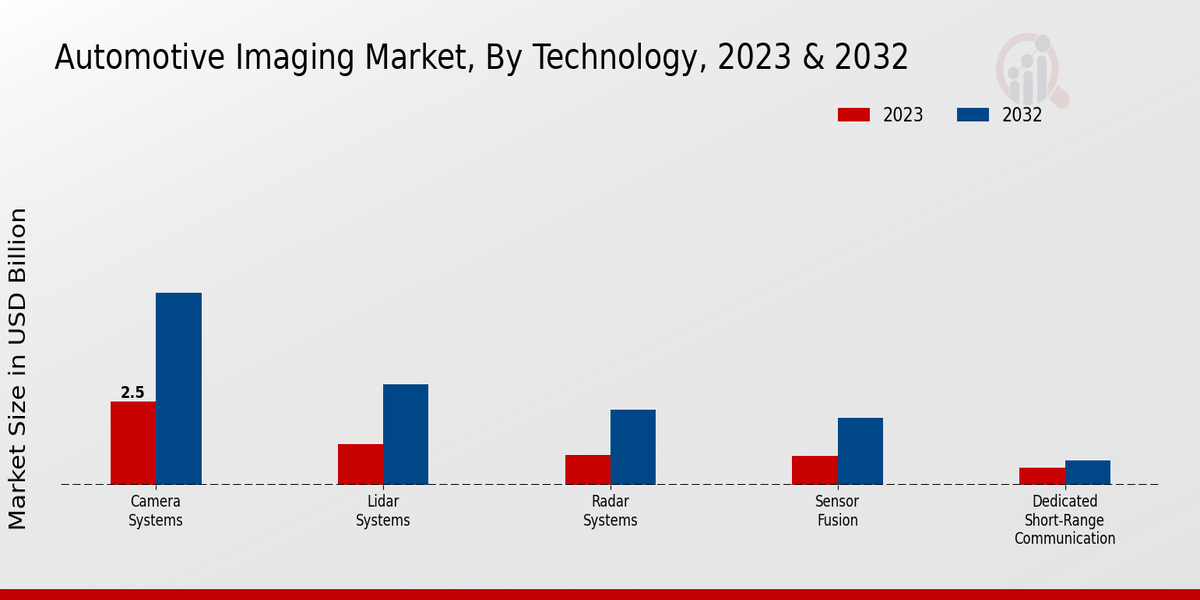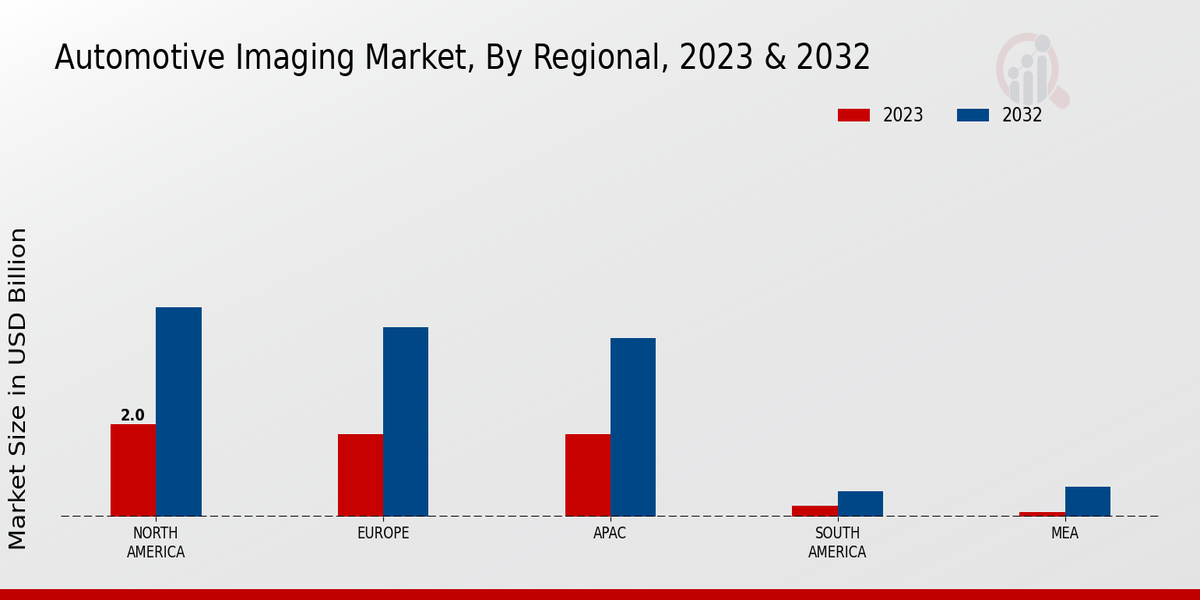Automotive Imaging Market Overview
As per MRFR analysis, the Automotive Imaging Market Size was estimated at 7.16 (USD Billion) in 2024. The Automotive Imaging Market Industry is expected to grow from 7.86 (USD Billion) in 2025 to 18.15 (USD Billion) till 2034, at a CAGR (growth rate) is expected to be around 9.74% during the forecast period (2025 - 2034).
Key Automotive Imaging Market Trends Highlighted
The automotive imaging market is currently experiencing significant growth, driven primarily by the increasing demand for enhanced vehicle safety and advanced driver-assistance systems. Key market drivers include the rising adoption of technologies such as cameras and radar systems in vehicles to support functions like lane departure warnings, obstacle detection, and parking assistance. Additionally, consumer preference for high-quality imaging solutions in infotainment systems has further propelled the integration of advanced imaging technologies in cars. There are numerous opportunities to be explored in this market. The emergence of autonomous vehicles presents a major growth area as they rely heavily on advanced imaging systems for navigation and obstacle recognition.
Moreover, as automotive manufacturers strive to meet stringent safety regulations and improve consumer experience, there is a growing need for innovative imaging technologies, presenting avenues for companies to invest in research and development. The integration of artificial intelligence and machine learning with automotive imaging also opens doors to new functionalities, such as facial and emotion recognition, for more personalized driving experiences. Recent trends indicate a shift towards multi-functional imaging solutions that combine several features into one system, enhancing overall vehicle performance and safety. Additionally, there’s a focus on integrating imaging technologies with the Internet of Things, enabling real-time data sharing and improved connectivity between vehicles.
This shift towards smarter imaging solutions is shaping the future of automotive technology, making it essential for stakeholders to adapt to these evolving demands. As electric vehicles gain prominence, the role of imaging technology in sustainable design and production is also becoming increasingly important, aligning with broader industry goals for efficiency and environmental responsibility.

Source Primary Research, Secondary Research, MRFR Database and Analyst Review
Automotive Imaging Market Drivers
Increasing Demand for Advanced Driver Assistance Systems (ADAS)
The Automotive Imaging Market Industry is experiencing significant growth, primarily driven by the increasing demand for Advanced Driver Assistance Systems (ADAS). In recent years, the automotive industry has witnessed a paradigm shift towards enhancing vehicle safety and performance through technology. This surge in demand can be attributed to several factors, including stringent government regulations aimed at reducing road accidents, the pressing need for improved road safety features, and a growing consumer preference for vehicles equipped with advanced safety technologies.
The integration of sophisticated imaging systems, such as cameras and sensors, plays a pivotal role in enabling ADAS functionalities. These imaging technologies facilitate features like adaptive cruise control, lane departure warnings, and collision avoidance systems. As automakers continue to innovate and invest in ADAS, the Automotive Imaging Market Industry is poised for substantial growth, aligning with evolving consumer expectations and regulatory requirements.
Moreover, the advancements in imaging technology, including resolutions and processing capabilities, have further bolstered the effectiveness of ADAS, making it an essential component in modern vehicles. The ongoing development of autonomous driving technology also fuels the demand for advanced imaging solutions, creating a robust market landscape. The convergence of these factors signifies a promising trajectory for the Automotive Imaging Market Industry as it becomes an integral part of future mobility solutions.
Technological Advancements in Imaging Solutions
Technological advancements in imaging solutions are significantly driving the Automotive Imaging Market Industry forward. Innovations in imaging technology, such as high-resolution cameras, LiDAR, and thermal imaging, enhance the capabilities of automotive systems. These advancements provide improved object detection, night vision, and expansive field-of-view, which are crucial for both safety and comfort while driving. As automotive manufacturers increasingly prioritize connectivity and automation, the demand for advanced imaging solutions continues to grow, contributing to the market's expansion.
Growth in the Electric Vehicle (EV) Market
The rapid growth of the electric vehicle (EV) market is another key driver influencing the Automotive Imaging Market Industry. As more consumers seek environmentally friendly transportation options, the demand for EVs is skyrocketing. The integration of advanced imaging systems enhances the driving experience by enabling features such as parking assistance and real-time monitoring of the vehicle's surroundings. Furthermore, as automakers develop new EV models, the incorporation of high-tech imaging solutions becomes essential, further fueling market growth.
Automotive Imaging Market Segment Insights
Automotive Imaging Market Technology Insights
The Technology segment of the Automotive Imaging Market plays a crucial role in shaping the future of automotive safety and automation, reflecting a total market revenue of 5.95 USD Billion in 2023. This segment is poised for significant expansion, driven by the increasing adoption of advanced imaging technologies in vehicles for enhanced safety and performance. Camera Systems dominates this segment with a valuation of 2.5 USD Billion in 2023, accounting for a majority holding of the market. They provide essential inputs for driver assistance features such as lane departure warnings and blind-spot monitoring, thus enhancing overall vehicle safety and user experience.
Following closely, LiDAR Systems are valued at 1.2 USD Billion in 2023 and are gaining traction due to their high-resolution 3D mapping capabilities, which are vital in autonomous vehicle navigation. Radar Systems are also significant, with a valuation of 0.9 USD Billion in the same year, as they play a key role in adaptive cruise control and collision avoidance systems. On the other hand, Sensor Fusion complements these technologies by integrating data from multiple sources, valued at 0.85 USD Billion in 2023, enhancing decision-making capabilities for advanced driver-assistance systems (ADAS).
Lastly, the Dedicated Short-Range Communication segment, valued at 0.5 USD Billion, supports vehicle-to-vehicle and vehicle-to-infrastructure communication, driving the development of smart road systems and cooperative driving solutions. The Automotive Imaging Market segmentation highlights that as these technologies continue to evolve, they offer substantial opportunities for growth and innovation, particularly in enhancing vehicle autonomy and safety measures. The combined push towards advanced imaging solutions in the automotive sector not only fosters market growth but also reflects a broader trend of integrating technology into everyday driving experiences.
As the automotive landscape shifts towards electric and autonomous vehicles, the importance of these imaging technologies is set to increase, promising new advancements and greater market penetration in the years to come.
Source Primary Research, Secondary Research, MRFR Database and Analyst Review
Automotive Imaging Market Application Insights
The Automotive Imaging Market, valued at 5.95 billion USD in 2023, showcases a significant expansion driven by various applications. Advanced Driver Assistance Systems play a crucial role in enhancing vehicle safety and is a prominent area within this market. The push toward Autonomous Driving technologies is also a significant contributor, as imaging systems are essential for vehicle perception and navigation. Traffic Monitoring systems leverage imaging technologies to improve road safety and efficiency, while Vehicle Surround View systems enhance driver awareness and reduce accidents.
Emergency Braking Systems rely on automotive imaging for rapid response, contributing to a decrease in collision rates. The market segmentation reflects a strong emphasis on these applications, which are pivotal in addressing safety challenges and promoting seamless transportation. As the industry evolves, advancements in imaging technologies will provide opportunities for further innovation and integration into various automobile functionalities, leading to substantial growth in the coming years. Improving safety features and the growing demand for automated solutions are driving this trajectory of the Automotive Imaging Market revenue.
Automotive Imaging Market Vehicle Type Insights
The Automotive Imaging Market is projected to reach a valuation of 5.95 USD Billion in 2023 and is on a growth trajectory, driven by technological advancements and increasing demand for safety features in vehicles. Within the Vehicle Type segment, Passenger Cars are notably significant, as they represent the majority holding of market growth, attributed to consumer preference for advanced imaging systems for navigation and safety. Commercial Vehicles also play an important role, driven by the need for fleet management solutions that enhance operational efficiency.
The emergence of Electric Vehicles is noteworthy, as their growing popularity is accompanied by an increasing integration of imaging technologies to support autonomous capabilities. Hybrid Vehicles contribute to the diversification of the market as they combine traditional and electric-driven technology, necessitating advanced imaging systems for improved performance and safety. Overall, the Automotive Imaging Market segmentation illustrates a dynamic industry poised for rapid development in response to evolving consumer and regulatory demands.
The projected growth trends highlight substantial opportunities for innovation and market penetration, emphasizing the importance of adapting imaging technologies to suit varied vehicle types.
Automotive Imaging Market End-Use Insights
In 2023, the Automotive Imaging Market reached a valuation of approximately 5.95 USD billion, showcasing significant growth within the automotive sector. The segmentation of this market by end-use includes key areas such as OEMs, aftermarkets, and Fleet Operators. OEMs play a crucial role as they drive the demand for advanced imaging solutions during vehicle production, ensuring safety and enhancing driver experience. The Aftermarket segment has gained traction due to the increasing adoption of camera systems for vehicle upgrades and safety enhancements, highlighting the need for innovation in imaging technologies.
Likewise, Fleet Operators are becoming pivotal as more companies recognize the benefits of imaging solutions for improved vehicle management and monitoring. The overall market growth is underpinned by rising consumer demand for safety features and technological advancements in imaging, with the automotive imaging sector expected to flourish over the coming years, contributing significantly to the Automotive Imaging Market revenue and statistics. This evolving landscape presents ample opportunities for industry players while also posing challenges related to integrating new technologies within existing infrastructures.
Automotive Imaging Market Regional Insights
The Automotive Imaging Market revenue is projected to grow significantly across various regions, revealing important insights into market dynamics. In 2023, North America leads the market with a valuation of 2.0 USD Billion, reflecting its majority holding influenced by advanced automotive technologies and high adoption rates. Europe follows closely with a valuation of 1.8 USD Billion, driven by stringent safety regulations and a growing emphasis on autonomous vehicles. The APAC region, also valued at 1.8 USD Billion, showcases substantial growth potential due to rapid urbanization and increasing vehicle production.
In contrast, South America is valued at 0.25 USD Billion, indicating a developing market with opportunities yet to be fully realized. Meanwhile, the MEA region, at 0.1 USD Billion, represents the smallest segment, driven by emerging automotive markets and gradually increasing demand for advanced imaging solutions. Overall, the Automotive Imaging Market segmentation illustrates regional disparities, with North America and Europe dominating due to technological advancements and regulatory frameworks, while APAC shows significant growth prospects owing to its large market size and manufacturing capabilities.
This diverse regional landscape presents both challenges and opportunities for stakeholders in the Automotive Imaging Market industry.

Source Primary Research, Secondary Research, MRFR Database and Analyst Review
Automotive Imaging Market Key Players and Competitive Insights
The Automotive Imaging Market is a dynamic sector driven by the advancements in imaging technologies tailored for use within the automotive industry. This market encompasses a variety of imaging solutions, including cameras and sensors that enhance vehicle safety, facilitate automation, and support advanced driver-assistance systems. As automotive manufacturers strive towards increasing the capabilities of vehicles through enhanced imaging, there is palpable competition among key players who are innovating rapidly to meet the demands for high-resolution imaging and integrated smart solutions. With the growing importance of visual data in vehicle functionalities, companies are persistently focused on the development of cutting-edge technologies and exploring alliances that can help them create a broader range of applications in safety and automation.
Nikon has positioned itself prominently within the Automotive Imaging Market through its strong emphasis on high-resolution imaging systems and innovative camera technologies. The company's expertise in optics and sensor technologies allows it to offer comprehensive imaging solutions that cater specifically to the needs of automotive manufacturers. Nikon's commitment to research and development plays a crucial role in its ability to introduce advanced image sensors that enhance video quality, which is vital for driver assistance systems and surveillance applications. Furthermore, the brand's longstanding reputation for quality and reliability effectively bolsters its market presence, allowing it to forge strategic partnerships with leading automakers that seek high-performance imaging equipment to incorporate into their vehicles.
Samsung is another formidable player in the Automotive Imaging Market, leveraging its technology and innovation to establish a competitive edge. The company capitalizes on its expansive resources and cutting-edge semiconductor technology to produce superior image sensors that are increasingly incorporated into automotive systems, offering enhanced image clarity and performance in real-time applications. Samsung's integrated approach ensures that it stays ahead in the market by combining high-resolution imaging technology with advanced processing capabilities that support features such as driver monitoring systems and autonomous driving. Additionally, its investment in research and development drives continuous innovation, enabling Samsung to maintain a strong foothold in a rapidly evolving automotive landscape and positioning the company as a significant contributor to the future of vehicle imaging solutions.
Key Companies in the Automotive Imaging Market Include
-
Nikon
-
Samsung
-
STMicroelectronics
-
Texas Instruments
-
Micron Technology
-
Qualcomm
-
Apple
-
OmniVision Technologies
-
Infineon Technologies
-
Renesas Electronics
-
On Semiconductor
-
Sony
-
Analog Devices
-
Marvell Technology
-
Canon
Automotive Imaging Market Industry Developments
Recent developments in the Automotive Imaging Market have highlighted advancements in image sensor technology and a growing emphasis on vehicle safety features. Companies like Sony and OmniVision Technologies are at the forefront with innovative imaging solutions that enhance driver assistance systems and autonomous vehicles. On the other hand, Nikon and Samsung are expanding their portfolios, emphasizing high-resolution imaging systems tailored for automotive applications. The market is also witnessing increased investments from semiconductor giants such as STMicroelectronics, Texas Instruments, and Infineon Technologies, driven by the demand for advanced imaging in electric vehicles and smart transportation systems.
In terms of mergers and acquisitions, Micron Technology recently partnered with leading automotive manufacturers to integrate their imaging technologies into next-generation vehicles, signifying a shift towards collaborative growth in the sector. Meanwhile, Qualcomm's acquisition of imaging startups signifies its commitment to enhancing automotive digital experiences. This evolving landscape is fostering competitive growth among major players such as Apple and Canon, who are actively developing cutting-edge imaging solutions to meet the diverse needs of the automotive market, thereby positively impacting the overall market valuation and shaping future innovations in automotive imaging.
Automotive Imaging Market Segmentation Insights
Automotive Imaging Market Technology Outlook
Camera Systems
LiDAR Systems
Radar Systems
Sensor Fusion
Dedicated Short-Range Communication
Automotive Imaging Market Application Outlook
Advanced Driver Assistance Systems
Autonomous Driving
Traffic Monitoring
Vehicle Surround View
Emergency Braking Systems
Automotive Imaging Market Vehicle Type Outlook
Passenger Cars
Commercial Vehicles
Electric Vehicles
Hybrid Vehicles
Automotive Imaging Market End Use Outlook
OEMs
Aftermarket
Fleet Operators
Automotive Imaging Market Regional Outlook
North America
Europe
South America
Asia Pacific
Middle East and Africa
| Report Attribute/Metric |
Details |
|
Market Size 2024
|
7.16 (USD Billion)
|
|
Market Size 2025
|
7.86 (USD Billion)
|
|
Market Size 2034
|
18.15 (USD Billion)
|
|
Compound Annual Growth Rate (CAGR)
|
9.74% (2025 - 2034)
|
|
Report Coverage
|
Revenue Forecast, Competitive Landscape, Growth Factors, and Trends
|
|
Base Year
|
2024
|
|
Market Forecast Period
|
2025 - 2034
|
|
Historical Data
|
2019 - 2023
|
| Market Forecast Units |
USD Billion |
| Key Companies Profiled |
Nikon, Samsung, STMicroelectronics, Texas Instruments, Micron Technology, Qualcomm, Apple, OmniVision Technologies, Infineon Technologies, Renesas Electronics, On Semiconductor, Sony, Analog Devices, Marvell Technology, Canon |
| Segments Covered |
Technology, Application, Vehicle Type, End Use, Regional |
| Key Market Opportunities |
Advanced driver-assistance systems integration, Growing demand for autonomous vehicles, Increased adoption of electric vehicles, Rising focus on safety regulations, Expansion of smart city initiatives |
| Key Market Dynamics |
Technological advancements, Demand for safety features, Increasing electric vehicles, Regulatory compliance, Growth in autonomous driving |
| Countries Covered |
North America, Europe, APAC, South America, MEA |
Frequently Asked Questions (FAQ) :
The Automotive Imaging Market is expected to be valued at 18.15 USD Billion in 2034.
The expected CAGR for the Automotive Imaging Market from 2025 to 2034 is 9.74%.
North America is anticipated to have the highest market value of 4.54 USD Billion in 2032.
The Camera Systems segment is projected to be valued at 5.75 USD Billion by 2032.
Key players in the market include Nikon, Samsung, Qualcomm, and Sony, among others.
The LiDAR Systems segment is expected to reach a value of 3.0 USD Billion in 2032.
The Radar Systems segment is projected to be valued at 2.25 USD Billion in 2032.
The APAC region is expected to reach a market size of 3.88 USD Billion by 2032.
The Sensor Fusion segment is projected to reach a value of 2.0 USD Billion in 2032.
Growth opportunities exist due to increasing demand for advanced driver assistance systems and autonomous vehicles.

















